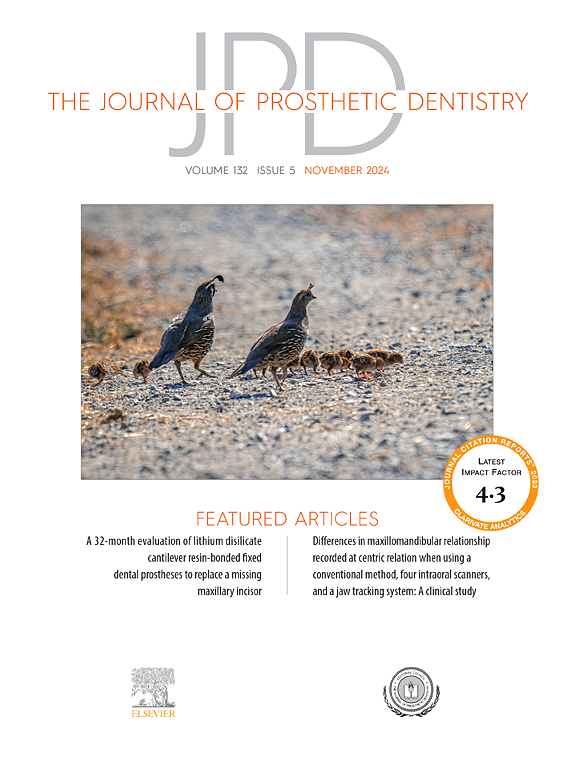Effect of stabilization of patients on the accuracy and scanning time of maxillary dentate quadrants: A clinical study
IF 4.8
2区 医学
Q1 DENTISTRY, ORAL SURGERY & MEDICINE
引用次数: 0
Abstract
Statement of problem
As intraoral scanning has gained widespread acceptance as an alternative to conventional impression-making, numerous studies have evaluated the influence of operator-related factors and patient-related factors on scanning accuracy. While several authors have noted patient movements as a clinical limitation of scanning technologies, research providing empirical data or testing this hypothesis is lacking.
Purpose
The purpose of this clinical study was to assess the effect of using the Zero Motion Scanning Band, a silicone occlusal mouth prop, and an OptraGate lip retractor for stabilizing the head and jaw on the accuracy (trueness and precision) and scanning time of digital quadrant scans.
Material and methods
A conventional impression was made of the maxillary right quadrant with polyvinyl siloxane material and then digitized using a calibrated extraoral scanner to create the reference file. Two different groups were created: no scanning aids (NSA) and with scanning aids (WSA). For the NSA group, scans were made without considering the participant’s movements. For the WSA group, scans included the Zero Motion Scanning Band, a silicone occlusal mouth prop, and an OptraGate lip retractor. Sixty-four scans were captured with an intraoral scanner (TRIOS 3) for each group, and the scanning time was recorded. Using an inspection and metrology software program, scans of each group were superimposed on the reference file to determine 3-dimensional (3D) deviations. The Kolmogorov-Smirnov test evaluated the normality of the distribution of variables, and the Mann-Whitney U test was selected for data analysis of non-normally distributed variables, including 3D deviations and scanning time (α=.05).
Results
Significant differences for trueness and scanning time mean values were observed under different scanning conditions: with and without head and jaw positioning (P<.05). The modified scan protocol exhibited higher trueness, with smaller mean root mean square values of 38.4 ±2.7 µm compared with 40.8 ±3.1 µm in the nonmodified group. However, precision did not display a statistically significant difference with varying scanning conditions (P>.05).
Conclusions
The use of the Zero Motion Scanning Band, a lip retractor, and a silicone occlusal mouth prop on the contralateral side of the scanned quadrant significantly improved the trueness and scanning time of the quadrant digital scan. Further evaluation of head and jaw stabilizing tools is recommended in more complex clinical scenarios, such as complete arch digital scans and scanning implant-supported restorations.
患者稳定对上颌齿状象限扫描精度和时间影响的临床研究
口腔内扫描作为传统印模制作的替代方法已被广泛接受,许多研究评估了操作者相关因素和患者相关因素对扫描准确性的影响。虽然有几位作者指出,患者运动是扫描技术的临床局限性,但缺乏提供经验数据或验证这一假设的研究。目的本临床研究的目的是评估使用零运动扫描带、硅胶咬合口腔支架和OptraGate唇牵开器稳定头颌对数字象限扫描的准确度(真实度和精度)和扫描时间的影响。材料和方法上颌右象限用聚乙烯醇硅氧烷材料制作常规印模,然后使用校准的口外扫描仪进行数字化,创建参考文件。分为两组:无扫描辅助(NSA)和有扫描辅助(WSA)。对于美国国家安全局的研究小组来说,扫描是在不考虑参与者动作的情况下进行的。对于WSA组,扫描包括零运动扫描带,硅胶咬合口腔支架和OptraGate唇牵开器。每组用口腔内扫描仪(TRIOS 3)捕获64次扫描,并记录扫描时间。使用检测和计量软件程序,将每组的扫描结果叠加在参考文件上,以确定三维(3D)偏差。采用Kolmogorov-Smirnov检验评价变量分布的正态性,采用Mann-Whitney U检验分析非正态分布变量的数据,包括三维偏差和扫描时间(α= 0.05)。结果在有无头颌定位的不同扫描条件下,正确率和扫描时间平均值有显著差异(P< 0.05)。改进后的扫描方案显示出更高的正确率,其均方根值为38.4±2.7µm,低于未修改组的40.8±3.1µm。然而,在不同的扫描条件下,精度没有统计学上的显著差异(P> 0.05)。结论在扫描象限对侧使用零运动扫描带、唇牵开器和硅胶咬合口腔支架可显著提高象限数字扫描的正确率和扫描时间。在更复杂的临床情况下,建议进一步评估头颌稳定工具,如全弓数字扫描和扫描种植体支持修复。
本文章由计算机程序翻译,如有差异,请以英文原文为准。
求助全文
约1分钟内获得全文
求助全文
来源期刊

Journal of Prosthetic Dentistry
医学-牙科与口腔外科
CiteScore
7.00
自引率
13.00%
发文量
599
审稿时长
69 days
期刊介绍:
The Journal of Prosthetic Dentistry is the leading professional journal devoted exclusively to prosthetic and restorative dentistry. The Journal is the official publication for 24 leading U.S. international prosthodontic organizations. The monthly publication features timely, original peer-reviewed articles on the newest techniques, dental materials, and research findings. The Journal serves prosthodontists and dentists in advanced practice, and features color photos that illustrate many step-by-step procedures. The Journal of Prosthetic Dentistry is included in Index Medicus and CINAHL.
 求助内容:
求助内容: 应助结果提醒方式:
应助结果提醒方式:


